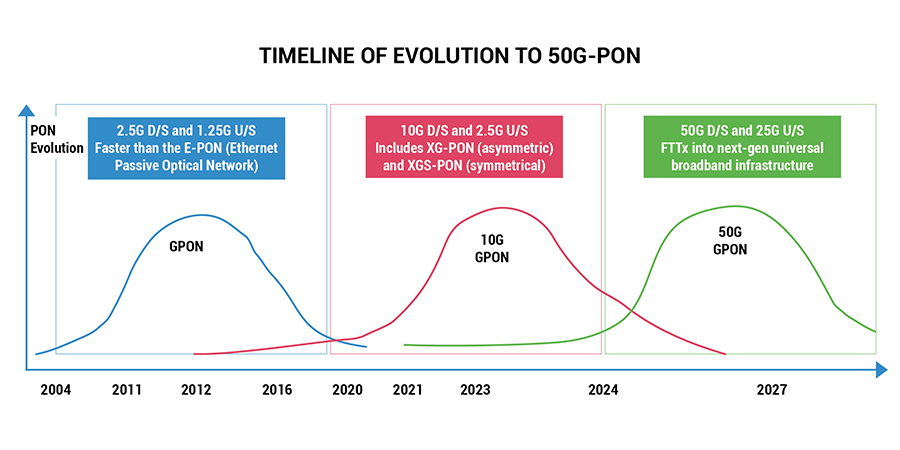A passive optical network (PON) is a fiber-optic access technology that distributes fiber-optic signals to multiple users through a passive splitter, achieving the goal of fiber-to-the-home (FTTH).
PON technology has the advantages of a high transmission rate, wide coverage, low cost, energy saving, and environmental protection, and it has become one of the mainstream technologies for broadband access.
PON Evolution
With the increasing demand of users for high-speed broadband access, PON technology is also developing continuously, from the initial GPON (Gigabit PON) and EPON (Ethernet PON) to the later 10G PON (10 Gigabit PON), and then to the latest 25G PON (25 Gigabit PON), the downlink rate of the PON technology has been increased by 25 times, reaching the level of 25Gbps.
The first generation is the EPON and GPON technology, they are mainstream applications now. The second generation is 10g technology, which is gradually being commercialized. The third generation is the 50G technology, they are still under discussion and development.

XGS-PON (10G symmetrical PON) networks are becoming more widely deployed, already delivering multi-gigabit connectivity to businesses worldwide. There are now 1 million PON lines worldwide capable of 25G PON, enabling operators to address 10G opportunities very efficiently, and that number is growing fast.
25G PON is the most optimized solution for the 10G era, and here’s why:
- It is available, mature, and being deployed today. No need to wait and lose opportunities to competitors.
- It is easy to introduce. The OLTs and line cards in use today for GPON and XGS-PON can also support 25G PON. It’s just a case of plugging in the 25G transceiver.
- There’s a huge capacity for 10G business services and beyond, with enough bandwidth left over for residential broadband and mobile backhaul.
- It’s the most power-efficient technology for the 10G era. 25G PON delivers a 10-fold capacity boost over GPON for only a 2.5-fold power increase, consuming 0.25 watts per gigabit.
- 25G PON’s limited power consumption allows an ONU to be integrated in an SFP form factor (aka ONU on the stick) for business and mobile transport applications, while this is not sure for 50G PON.
- Backward compatibility with GPON and XGS-PON and forward compatibility with 50G PON make for assured migration paths.
- It’s cost-efficient as 25G optics and electronics are mature, with component prices coming down faster than 10G components. Since 25G PON is available on existing hardware, there is very little additional investment to be made.
10G PON and 25G PON are the new generation technologies of passive optical networks with high-speed, compatible, reliable, and energy-saving features, which are suitable for a variety of application scenarios and are the future trend of broadband access and data transmission.
References:
- Nokia, Why 25G PON is right for the 10G era.
- F5, The Future-Proofing Power of 25G PON: Preparing for Tomorrow’s Demands.
